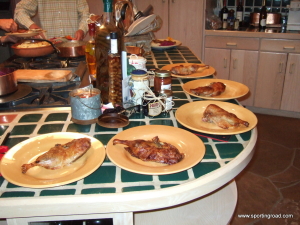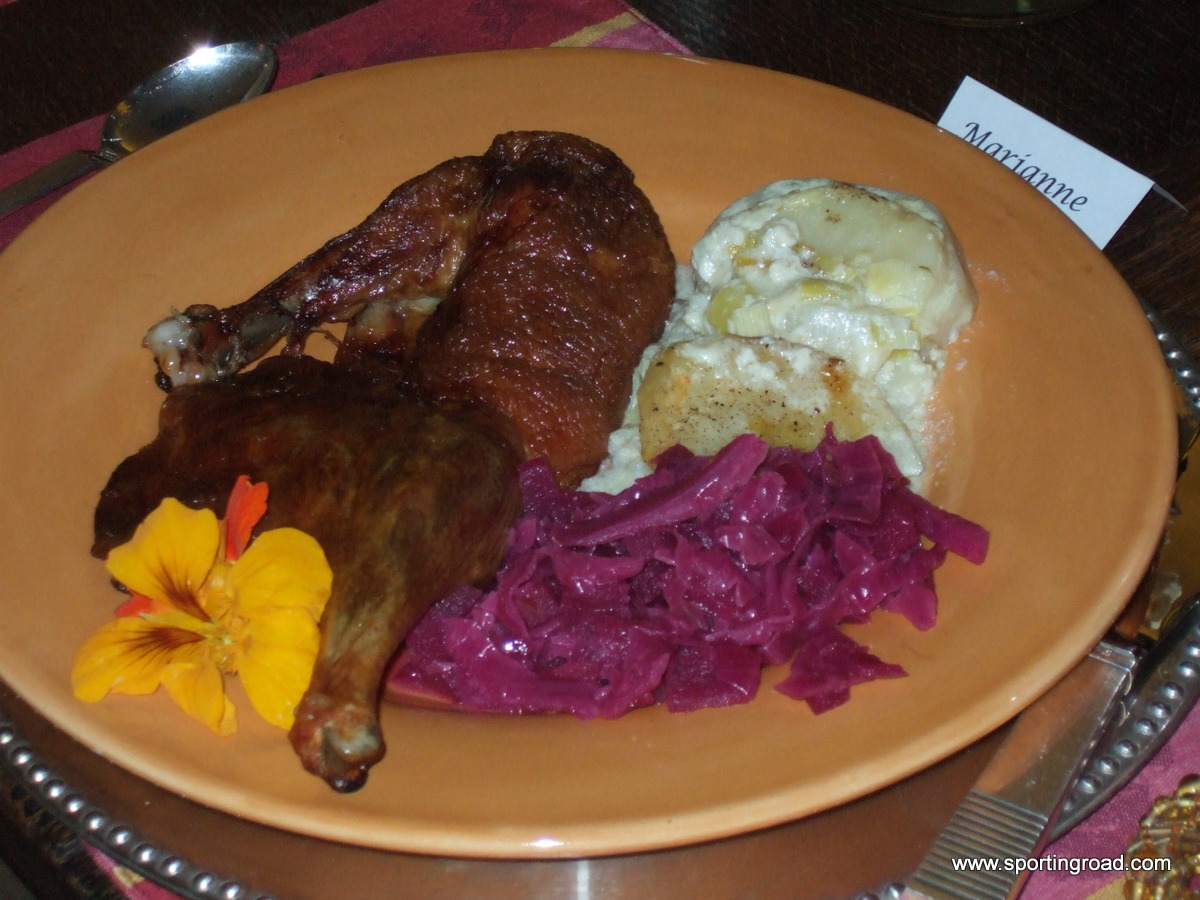Honey Roasted Duck Legs (Dui Vit Quary Mat Ong)
By Andrea Nguyen, Author, Into the Vietnamese Kitchen:
Treasured Foodways, Modern Flavors
Serves 4 to 6 with 2 or 3 other dishes
4 cloves garlic, smashed with the broad side of a cleaver or chef’s knife
Chubby 1-inch piece fresh ginger, thinly sliced and smashed with the
broad side of a cleaver or chef’s knife
¾ teaspoon Chinese five-spice powder
¼ teaspoons salt
6 tablespoons honey
2 tablespoons light (regular) soy sauce
1 tablespoon dark (black) soy sauce
1 tablespoon Shaoxing rice wine or dry sherry
¾ teaspoon salt
2 tablespoons Shaoxing rice wine or dry sherry
2 teaspoons peeled and grated fresh ginger, pressed through a fine-mesh sieve to extract 1 teaspoon juice
6 whole duck legs, trimmed of excess fat and skin and backbone removed, if necessary
2 tablespoons hoisin sauce
- To make the glaze, in a small saucepan, combine the garlic, ginger, five-spice powder, salt, honey, light
and dark soy sauces, and wine. Place over medium heat and bring to a boil. Remove from the heat. When the
bubble action ceases, pour the glaze through a fine-mesh sieve place over a medium-sized bowl, pressing on
the solids with the back of a spoon to extract as much liquid as possible. Let the glaze cool completely.
2. Select a large, shallow bowl or deep plate that fits in your steamer tray. Add the salt, wine, and a ginger
juice and stir to dissolve the salt. Add the duck legs and use your fingers to coat the duck legs well with the
marinade. Arrange the duck legs so that there is minimal overlap, to ensure even cooking. Put the bowl in
the steamer tray and set aside to marinate for 15 minutes.
3. Fill the steamer pan halfway with water and bring to a rolling boil over high heat. Add the steamer tray,
cover, and steam the duck for 25 minutes. The skin will pull back from the flesh, and cooking juices will
collect in the bowl. Transfer the duck legs to a plate and discard the cooking juices. (The legs may be cooled,
wrapped in a plastic wrap, and refrigerated overnight. Bring to room temperature before roasting.)
4. Position a rack in the lower third of the oven and preheat to 425°F. To promote heat circulation and
allow fat to drip away from the duck, place a flat roasting tack on a foil-lined baking sheet. Put the duck,
skin side up, on the rack, spacing the legs as far apart from one another as possible. Roast for 35 to 40
minutes, or until the skin is crisp and lightly golden. Turn on the exhaust fan as the duck roasts, as the
dripping fat can cause smoke. If more than 2 tablespoons of fat accumulates in the pan during roasting,
remove the duck from the rack, make a spout in one corner of the foil, and pour off the fat. Then quickly
return the duck to the rack and continue roasting.
5. When the duck is ready, using tongs, lift each leg from the rack, roll it in the glaze to coat evenly, and
hold it above the bowl to allow excess glaze to drip off. Return the duck to the rack, skin side up. Roast the
legs for 5 minutes and then again coat them with the glaze. Roast for 3 to 5 minutes longer, or until the glaze
richly covers the duck. Remove from the oven and let cool for 10 minutes.
6. After glazing the duck legs the second time, return the remaining glaze to the small saucepan and add the
hoisin sauce to make a dipping sauce. Warm over medium heat, adding a spoonful or two of water if needed
to balance out the flavor. Pour into a small serving bowl. Using a heavy cleaver, chop the legs through the
bone into bite-sized pieces. Or, slice the meat off the bone. Arrange the duck on 2 plates or a platter and
serve with the sauce.


Leave A Comment
You must be logged in to post a comment.